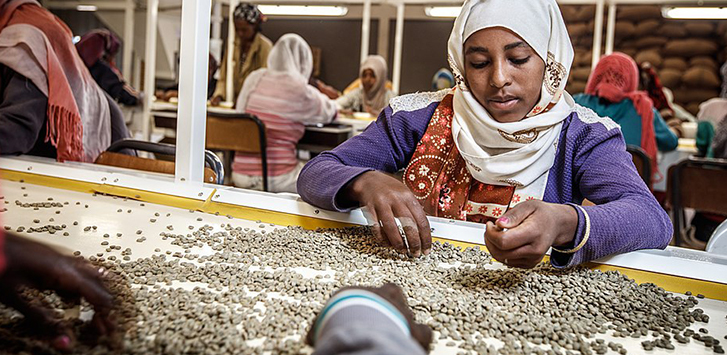
Ethiopia is the birthplace of coffee. With the perfect climate for coffee growing, this makes complete sense. Some even say that the original Ethiopian name for coffee, “Kaffa bunn,” was anglicized into the word we know today, “coffee.”
Nowadays, Ethiopia is the 5th largest coffee producing nation in the world, and the highest coffee bean-producing, African nation. Ethiopian coffee beans are well-known for both their acidity and delicate, fruity flavors that create a delicious cup of coffee.
Ethiopia boasts over 10,000 coffee bean varieties that are specific to different regions throughout the country. Sidamo creates a crispy, citrusy coffee. Yirgacheffe is bright and floral, and Harrar produces an intense, heavy-bodied coffee. These are the three top-producing regions in Ethiopia, and some of the most well-known coffee beans.
Ethiopian Coffee Culture and Ceremony
Folklore says in 850 A.D., a goat herder named Kaldi saw his goats acting strangely near a bush with red berries. Curious, Kaldi ate a berry and immediately noticed how energized he felt.
Kaldi gathered some berries and took them to a nearby monastery. Once the monks heard his story, they declared the berries were “the Devil’s work,” throwing them into a nearby fire. The roasting berries smelled so good, though, that the monks relented and began to use them to achieve greater spiritual devotion. Since then, Ethiopia has always attributed a spiritual element to coffee.
Coffee is an integral part of Ethiopian culture. Over the centuries, coffee has become an expression of friendship and respect. In Ethiopia, this culminated in the coffee ceremony and, eventually, overflowed into daily life and sayings. For example:
Buna dabo naw – Coffee is our bread
Buna Tetu – Drink coffee (This phrase also means go socialize as the two activities, drinking coffee and socializing, are often combined.)
The Ethiopian coffee ceremony is an essential part of the Ethiopian culture. It symbolizes respect, friendship, and spiritual transformation. The 2-3 hour long ceremony is performed three times a day (morning, noon, and evening) by the woman of the house.
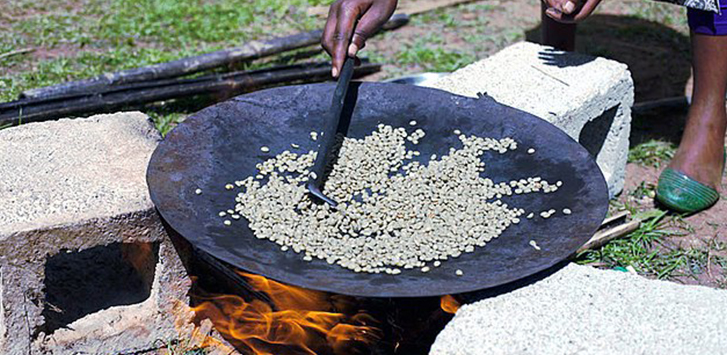
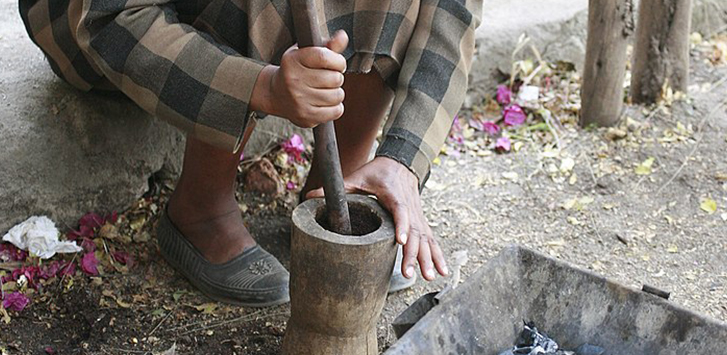
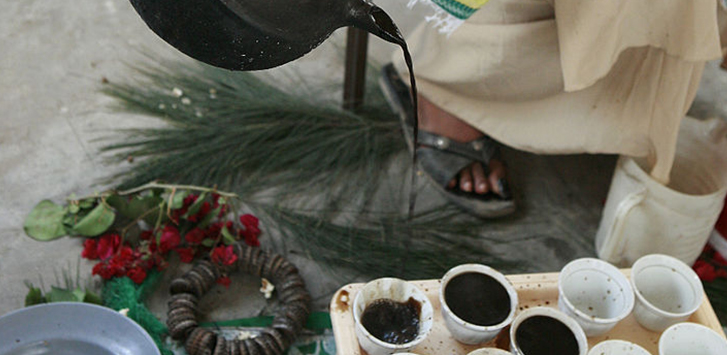
First, the woman prepares the room by spreading aromatic flowers and grasses throughout and burning incense to ward off evil spirits. Next, they heat a coffee pot, called a "jebena," over coals. Meanwhile, the woman cleans, roasts, and grinds the green coffee beans.
Once the hostess finishes grinding the coffee beans, she pours them into the heated water. The hostess holds the coffee a foot above small, handle-less cups and continuously pours across the line.
Guests add sugar to their cup and then praise the hostess for her coffee-making abilities. Guests drink three cups of coffee. Each cup has a weaker taste, but each cup is important. Ethiopians believe that each cup brings a greater spiritual transformation.
Ethiopian Coffee Production
Coffee plants have grown in the wild in Ethiopia for centuries. Its growing conditions are perfect. The coffee beans from the south have a balanced, light, acidic, and fruity taste. This is because of the tall mountains, good soil, and lush vegetation in the region.
Because many of the coffee cherries grow on the mountains, they are classified as strictly high grown (SHG). Chemicals are often not required for growth aids, resulting in highest quality specialty coffee.
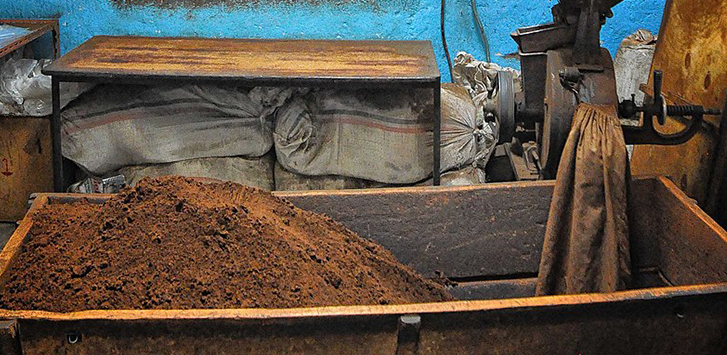
Ethiopian coffee beans undergo two different processes, natural processing and wet processing (also called washed processing). Naturally-processed coffees tend to have fruity or winey acidity with complex notes of blueberry and deep chocolate undertones. The medium to heavy body is syrupy in consistency and has a dry edge to it.
Washed beans boast jasmine or lemongrass characteristics with a lighter and drier body. Washing is a newer process that is constantly evolving as new equipment comes on the scene. Naturally-processed is the traditional way of processing the beans and is still the most common way of doing so.
Different Types of Ethiopian Coffee
Ethiopia produces a hard, dense, small bean that has more sugar and flavor because of its physical characteristics. But, the flavor profiles are distinct based on region.

There are nine distinct growing regions in Ethiopia: Yirgacheffe, Sidamo, Harrar, Bebeka, Teppi, Limu, Djimma, Illubabor, Lekempti, Wellega, and Ghimbi. Within all nine regions, Fair Trade Organic certified coffees are abundant. Between this and the refreshing flavor profiles, finding a single origin Ethiopian coffee is well worth the effort.
Here are a few characteristics of some of the coffee beans offered by Ethiopia:
HARRAR – A dry-processed bean with fruity or winey flavors, notes of blueberry, and bright acidity. It makes a medium to heavy-bodied coffee with a slight dryness.
GHIMBI – A washed bean that creates a rich, heavy-bodied, well-balanced coffee with sharp acidity and complex flavors and aromas.
LIMU – A washed bean that produces a low-acidic, well-balanced coffee that’s both sweet and vibrant. This bean has underlying winey, spicy flavors.
LEKEMPTI – Lekemti produces a coffee similar to the Harrar with its body but with slightly distinct, fruity flavors and pleasant acidity.
YIRGACHEFFE - The Yirgacheffe has an almost overpowering aroma, and the equally strong taste isn't a letdown. You'll taste sweet chocolate, honey, fruit, and finish with smooth caramel. This complex coffee is as bright as it is bold. The Yirgacheffe is powerful enough to get you going in the morning and beloved enough to be a hit with friends.
SIDAMO - This southern region is known for its highly valued coffee beans. It is the main coffee-producing area in the country. Sidamo coffee beans are admired for their brightness and fruit-forward flavors.
How to Roast Ethiopian Coffee Beans
WHAT TO DO:
A medium roast provides the best balance of acidity, flavors and body. If the roast gets too dark, the flavors are covered up.
Learning how to get that perfect roast is hard, though. Ethiopian coffee beans are finicky and small, making it hard to roast them well. You have to pay close attention to the entire roasting process.
To roast your Ethiopian beans, you should follow some basic principles.
- Set aside a sample roast before you do a larger batch to get the perfect temperature and roasting time.
- Slowly increase the temperature around the first crack. A slow roast style will help you achieve your preferred roast profile.
- Keep in mind that naturally-processed beans darken faster than washed beans.
WHAT NOT TO DO:
Avoid any sudden, intense heat. This will destroy the subtle, delicate flavors and floral notes in the coffee beans.
If you're using washed coffee beans, intense heat will also cause under-development around the first crack, ruining the batch.
If you're using naturally-processed beans, a temperature spike before the first crack will cause roast defects. This includes a burnt exterior or under-developed interior.
After you’ve figured out the best way to roast your Ethiopian coffee beans, let them rest for a few days. Then, grind and brew them (fresh is always best!) or store them until you want to use them later.
How to Brew Ethiopian Coffee
Since Ethiopian coffee has a light body and brighter acidity, filter-based brewing methods create the best cup of coffee.
AUTOMATIC DRIP
If your coffee beans were freshly roasted and ground, an automatic drip makes a great cup of coffee. The paper filter clarifies the flavors, emphasizing a winey acidity and full bodied mouthfeel.
POUR OVER
If you really want a good cup of coffee, you should use a pour over, though. This brewing method gives you more control, while slowing down the brew so the coffee absorbs all the flavors.
If you have washed coffee beans, try a Chemex. The thicker paper filters emphasize the tea-like body and clean, bright notes.
If you have natural beans, try a Hario V60. The thinner paper filter allows the syrupy, heavy-body to remain intact with bright acidic and fruity notes throughout.
COLD BREW
Cold brew is always refreshing and even more so with Ethiopian beans. It’s perfect for that smooth, clean texture with notes of blueberry or peach. If you grind your own coffee beans, make sure to use a coarse grind. A coarse grind will ensure the cold brew does not turn overly acidic.
Conclusion
With over 10,000 coffee varieties and a rich coffee culture, Ethiopia has much to offer the coffee world. If you’re looking for some new coffee beans to try, make sure to pick up some Ethiopian green coffee beans!